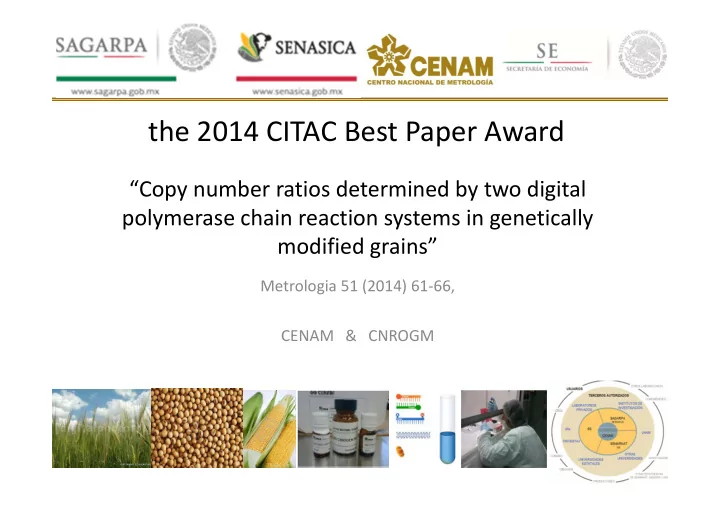

the 2014 CITAC Best Paper Award “Copy number ratios determined by two digital polymerase chain reaction systems in genetically modified grains” Metrologia 51 (2014) 61 ‐ 66, CENAM & CNROGM
• Participating Laboratories and Authors: 1. CNRDOGMs ‐ SENASICA. M. en C. Abraham Acatzi. Tecamac Edo. De México CENTRO NACIONAL DE REFERENCIA EN DETECCIÓN DE OGM Carretera Federal México-Pachuca km 37.5 C.P. 55740, Municipio de Tecámac, Estado de México Tel. (55) 5905-1000, Ext. 53040 abraham.acatzi@senasica.gob.mx 2. CENAM. Santiago de Querétaro. Dra. Melina Pérez Urquiza National Health Service, Food Safety and Quality (SENASICA) The National Reference Center for Detection of Genetically Modified Organisms (CNRDOGM)
• Background • In 2009 Secretary of Economy as one of the three Secretary of States promoted the initiative to create Laboratory Network for GMO detection, in which CENAM was requested to develop higher order reference methods and materials. • México approved in 2005 a biosecurity law for genetically modified organisms • A laboratory network to determine GMOs and D&C of RM was required • Round robin step 1 (2010 ‐ 2011) 9 laboratories • Round robin step 2 (2011 ‐ 2012) 12 laboratories • Round robin step 3 (2012 ‐ 2013) 15 laboratories
• Metrological traceability is assumed for the copy number of sequences or molecules determined of the modified gene and endogenous gene. CENAM developed with CNDROGM under SAGARPA research project funded by the Secretary of Agriculture, Rural Development and Food (SAGARPA) and CONACYT, from 2013 ‐ 2014 and certified CRMs for GMO copy number ratios for maize. 15 Institutes participated in the comparison studies.
• In this study, the general uncertainty contribution from the between ‐ vial inhomogeneity was around 1 % and the corresponding one from the long ‐ term stability was also around 1 % with the exception of DMR 495 IIa, where it was obtained to be around 2 %. The expanded uncertainty of the more concentrated materials identified as IIa in the range between 4 % and 8 %, while the more diluted materials (1 % GM) identified as IIIa it is from 11 % to 22 %.
• No statistical differences was found between the results obtained for the two digital PCR platforms by using the t and F ‐ statistics in the three matrixes studied, maize, soybeans and wheat, for the GMO markers. We learned that • By using CRMs in copy number fraction as a control material and blind samples it is possible to harmonize the results of measurement and validate the methodology with the lowest uncertainty.
• Continuous improvement – By using a duplex measurement methodology (transgenic/reference genes) the uncertainty of measurement can be reduced to less than 2 %. …next publication soon Dra. Melina Pérez Urquiza Centro Nacional de Metrología (CENAM) meperez@cenam.mx
Thank you so much to CITAC for the distinction, we feel really honored at CENAM! Muchas Gracias! Merci beaucoup! Many thanks! Danke sehr! 有難う御座います ! Bolshoye spasibo!
Recommend
More recommend